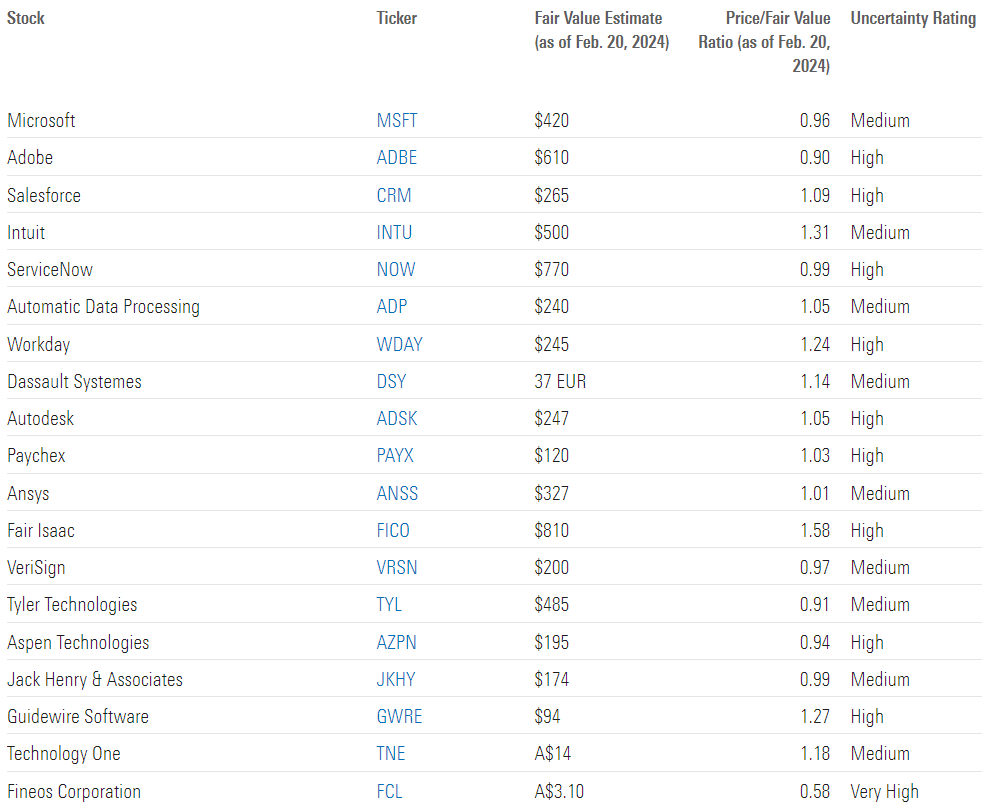:quality(80)/cloudfront-us-east-1.images.arcpublishing.com/morningstar/LA45DOADQZGU7DV5BE4ETVZ4M4.png)
Overall, we think revenue and margin expansion is looking favorable for software firms in the coming years: We see total software revenue growing in excess of 10% annually through 2027.
Our outlook for the industry centers on three key themes:
- Switching costs drive high customer retention.
- High upfront investments secure very sticky revenue.
- Growth should remain attractive.
We share the key tailwinds and headwinds that will steer the industry and an overview of the moatiest companies.
Get the full report: 2024 Software Landscape Report
The Future Remains Bright for Software Firms
Software industry revenue growth is derived from existing clients in the form of additional seats and new modules and from new vendors and new business formation. Pricing tends to be lumpy, as software vendors may raise prices by 10% once every three years rather than annually by 2% to 3%. The year 2023 was a busy one for price hikes, as vendors pulled that lever well above normal historical levels.
While Gartner provides widely followed software industry data, our bottom-up forecast is slightly less aggressive over the next two years, which we attribute to our view of heightened macroeconomic uncertainty lasting throughout 2024.
Key tailwinds include:
- Artificial intelligence. We see demand for generative AI use cases fueling software growth in the coming years.
- Data. The exponential growth in data and need for storage will only multiply. Software firms have the expertise to organize, protect, and use this data.
- Public cloud. The rise of public cloud has driven heavy software investment across industries. Firms take on the expertise of hybrid or cloud native software firms to support the transition from on-premises to cloud.
- Digital transformation. Accelerated by the pandemic, there is a push for firms to implement digital workflows.
Key headwinds include:
- Higher interest rates. Higher interest rates make it more expensive to fund growth as a software firm (via debt and via PE funding) and can also lead to leaner budgets for customers.
- Economic downturn. Customers tightening their IT budgets in tough macroeconomic times, or macro factors like foreign exchange pressures.
- Privacy concerns. Reluctance to onboard software or digitize workflows because of data privacy concerns, which hampered software-as-a-service and public cloud growth early on.
- Regulation. One of the most significant risks to slow innovation is regulatory intrusion.
Switching Costs Drive Software Firms’ Moats
Software firms within our coverage overwhelmingly have moats, with a majority garnering narrow moats and many earning wide moats. Moats in the software industry are largely driven by switching costs, with occasional support from network effects or even intangible assets.
There isn’t a single example of a software company within our coverage that is awarded a moat without benefiting from switching costs. Once an application is installed, employees become proficient in it, and the client builds business processes around it and even integrates it with other applications within the organization. Changing software applications, then, is more complicated than swapping vendors.
Network effects are also relatively common within the software industry, although we see them typically as a secondary moat source. They occur when the value of the platform increases with the number of platform participants.
The table below maps out the 18 software companies within our coverage that earn a wide moat.

High Upfront Investments Secure Very Sticky Revenue
Software firms invest heavily in research and development to create differentiated applications and in a salesforce to secure customers. On average, software companies spend 21% of their revenue on R&D efforts.
This means there’s a lot of spending upfront, and software companies can be unprofitable from an accounting viewpoint during early, high-growth periods.
However, strong customer retention for moaty firms creates an annuity-like revenue stream that pays for these costs over time. Customer acquisition costs may be high in year one, but when a customer sticks around for 10 or more years, the lifetime value of this customer can be very high—often greater than 3 times the acquisition cost.
Growth in the Software Industry Should Remain Attractive
We see total software revenue growing in excess of 10% annually through 2027, including approximately 14% in 2024.
We find that the acceleration of growth in 2021 and deceleration in 2022 were distorted by remote work investments during covid lockdowns. A more cautious demand environment for enterprise buyers in 2023 has created additional worries about software growth, but we see double-digit percentage growth for the foreseeable future.
Overall, we believe increased automation, a focus on customer-centric software, and generative AI will drive growth. The software industry should continue to offer attractive revenue growth for investors.
Infrastructure Software Should Remain a Larger Market Than Applications
We see total software revenue growing in excess of 10% annually through 2027.
:quality(80)/cloudfront-us-east-1.images.arcpublishing.com/morningstar/YW24AIUWCNCJ5BZN3RXYDKXRCI.png)
What About AI?
Database software is the largest category within infrastructure software, while customer experience is the largest category within application software, which is a dynamic we do not expect to change over the next five years.
Further, while they are the largest categories, we still expect they will also be the fastest-growing areas over the next five years.
We believe database-related solutions are growing because of the need to have data organized and prepared in order to apply generative AI. Customer experience grows because it helps users generate new sales.
Database and Customer Experience Remains the Largest Software Categories...
We believe database-related solutions are growing because of the need to have data organized and prepared in order to apply generative AI.
:quality(80)/cloudfront-us-east-1.images.arcpublishing.com/morningstar/A7V5DT3Q6JBVHEOK34ZWHVPHHQ.png)
And They Are Also Growing the Fastest
Despite being the largest categories, we expect database software and customer experience will also be the fastest-growing areas over the next five years.
:quality(80)/cloudfront-us-east-1.images.arcpublishing.com/morningstar/4EQNX7RVC5AWZI3QI7CWTU54NQ.png)






:quality(80)/cloudfront-us-east-1.images.arcpublishing.com/morningstar/ZPLVG6CJDRCOTOCETIKVMINBWU.png)

.jpg)










